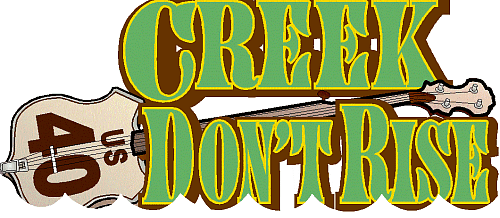Is My Autoharp a Type A or B?
If you're considering buying a used Autoharp that may need restoration or have acquired one, you might be confused by whether your autoharp will need "Type A" or "Type B" strings.
That designation is used to designate the difference between pre-1968 and post-1968 Autoharps. That was the year, Oscar Schmidt made several significant changes to their Autoharps. The original boxy shape was fine for playing on a table or in the lap, but when players started playing them upright, different ergonomics came into play. Plus the fact that a competitor was getting ready to release their own version of relatively ergonomic autoharps.
Fortunately, it's very easy to spot the differences between the pre-1968 Autoharps ("Type A") and the post-1968 Autoharps ("Type B").
By the way, if you have a Chromaharp, this article doesn't pertain to you. The vast majority of Chromaharps are the same size and shape and take the same kind of strings, so if you need to get strings or other parts, just make certain you get the type that says "Chromaharp."
Gross Generalities - Here's a very quick shortcut: If you have a 12-chord autoharp it is almost certainly a Type A. If you have a 21-chord autoharp, it is almost certainly a Type B. I say "almost certainly" because every time I think I have all the variations "figured out," I come across something I haven't seen before. Plus there is one current line of 21-chord type A Autoharps (discussed below).
If you have a 15-chorder, though, you have to read the rest of the article for sure. There are a lot of surviving 15-chord autoharps in both A and B configuration.
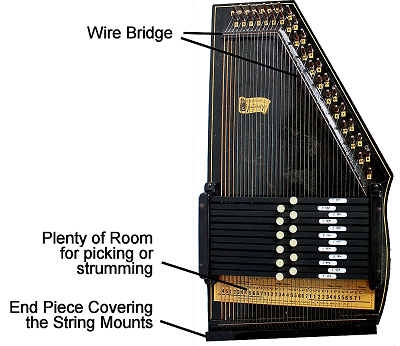 Type A Distinctives Type A Distinctives
If you have an old boxy autoharp like the one to the right, it's almost certainly a Type A. How to know for certain?
- The earliest profile has all straight lines and sharp corners except for one edge.
- The strings cross a wire bridge near the pins.
- There is substantial room between the chord bars and the mounting pins for you to pick or strum.
- There is an wood or plastic cover on the end that covers the mounting pins.
The Autoharp below right is a late Type A. The profile has changed to have more rounded edges, but it still has mostly straight lines, a wire bridge, and a cover over the mounting pins.
This autoharp i more comfortable to hold upright, and may be worth restoring if the condition is otherwise good. But it still takes Type A strings if you need to replace them.
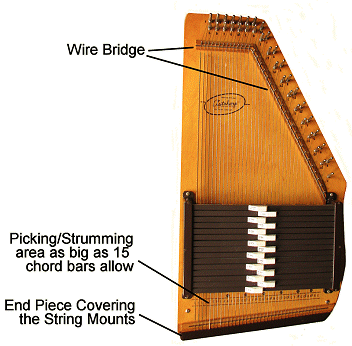
None of these models were made after 1968. The fact that so many of them are around in restorable condition is due to the sheer number of autoharps produced between 1910 and 1967.
New Type A Exception - There is one exception, however. You're not likely to come across one of these cheap because it's actually a sort of custom model - the OS73C and OS73CE (electric) reissues. These are in the shape of the original Type A, but were made in recent years, as a tribute to the Carter Family and others who made the original instrument famous.
Technically, the first OS73CE reissue was created for Catherine O'Hara to strum in the Folk-themed Christopher Guest mocumentary A Mighty Wind, but lots of folks fell in love with the thing and new ones are still available.
There are 15-chord versions, as well as the 21-chord version shown below. Keeping in mind, of course that the original OS73 line never had a 21-chord version. 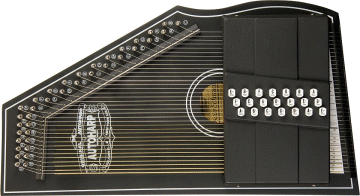 There is one other difference between this autoharp and all the other Type As that is worth noting. As you can see, the cord bars are skooched as far toward the end of the instrument as possible, giving the maximum amount of room to strum the higher strings in upright playing. Of course, nobody but an autoharp player would know that, so you can still use the thing for historical reenactments, if you want to. There is one other difference between this autoharp and all the other Type As that is worth noting. As you can see, the cord bars are skooched as far toward the end of the instrument as possible, giving the maximum amount of room to strum the higher strings in upright playing. Of course, nobody but an autoharp player would know that, so you can still use the thing for historical reenactments, if you want to.
If you have your heart set on a very traditional-looking 21-chord instrument and if you have very deep pockets, this one may be the one for you.
Or Build Your Own - Or if you have more time than money, you COULD pick up an old, but solid Type A for under $50 and buy a new set of strings and the 21-chord conversion kit from Elderly music. Okay, that's a LOT of work, and it would still cost you close to $250, but you could make the thing Folk-friendly while you're at it.
Type B Distinctives
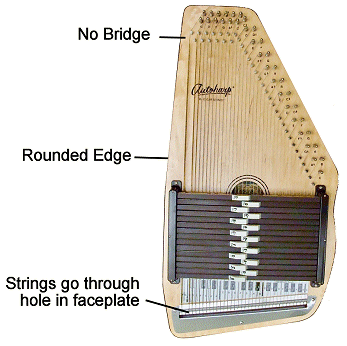 By 1967, with rumors of a Japanese competitor (Chromaharp) coming out with an even more ergonomic model than the late Type As, Oscar Schmidt was reengineering their Autoharps altogether. The new line came out in 1968, the same year as the Chromaharps, probably saving Oscar Schmidt's place in the industry. The Type B instrument had both practical and cosmetic improvements. By 1967, with rumors of a Japanese competitor (Chromaharp) coming out with an even more ergonomic model than the late Type As, Oscar Schmidt was reengineering their Autoharps altogether. The new line came out in 1968, the same year as the Chromaharps, probably saving Oscar Schmidt's place in the industry. The Type B instrument had both practical and cosmetic improvements.
- The profile is even smoother; some would say more ergonomic.
- The bridge is gone; instead of crossing little pins and a wire bridge, the strings now simply cross a row of more substantial pins and no bridge. This required more precise engineering of the tuning pegs, but OS seemed to think it was a good trade-off.
- The chord bars are moved down so that a player holding the thing upright has more access to the high strings than before. (This is more pronounced on current models.)
- The ends of the strings go down through a plate, so there is no cover on the end. What you can't see is that they've changed from loop to ball-end strings, something like guitar strings. In most cases, that makes it easier to replace strings quickly.
And of course the big difference is that all of their models became available in 21-chord versions as well. As time went on, they built higher- and higher-end models. Models with solid spruce tops, models with fine tuners, etc. So if you're looking for an Autoharp that shows that kind of quality and innovation, you'll be looking for Type Bs.
Incidentally, Chromaharp also came out with a 21-chord autoharp. To this day, their 15- and 21- chord autoharps compete well with Oscar Schmidts' baseline 15 and 12-chord Autoharps, but if you want to look for instruments with upgrade features and metter materials than the standard models, you'll be looking at Oscar Schmidt's. Or at more expensive custom models like D'Aigle.
Conclusion
When I was writing my first series of articles about autoharps, I bought several "basket cases" from various lines and eras so I could compare features, etc., without spending "real money."
Some of the "basket cases" turned out to be in better condition than I had expected. I wound up with a nice OSC21 as well - yes it's entry-level as 21-chorders go, but it's in cherry condition and sounds great.
The short version is that I am now the proud, if temporary, owner of several of these things from all different periods, and the fact is that I like them all. That includes the old Type A with the cracked soundboard that I got for about $15 and am half afraid to keep tuned up properly. It includes two or three others that aren't remotely playable (yet) but which I can tell have potential.
It's traditional in this kind of article to say which kind of instrument you might recommend, so here's a little guidance.
- From a sheer flexibility standpoint, I would say to get a 21-chorder if you can afford it - you'll be able to play in more keys.
- From a sheer practicality standpoint, I'd say to get one that won't need any refurbishment to tune up and play.
Both of those recommendations would tend to steer you toward a newer instrument, not only a post-1968, but even one that's less than twenty years old and has been stored properly.
But the truth is, if you have an autoharp of any era that you can keep in tune and play, you have a dandy little instrument with a lot of potential.
And hopefully this article helped you get a little closer to figuring out what kind of autoharp you have or are looking at.
Best of luck!
 Whatever else you get out of our pages, I hope you enjoy your music and figure out how to make enjoyable music for those around you as well. Whatever else you get out of our pages, I hope you enjoy your music and figure out how to make enjoyable music for those around you as well.
And please stay in touch!
- Paul









http://CreekDontRise.com
http://SchoolOfTheRock.com
http://classictrainsongs.com
| 